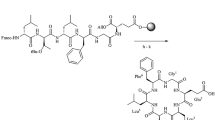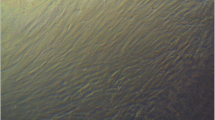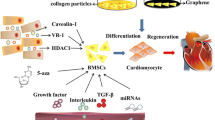Abstract
Bone marrow mesenchymal stem cells (BMMSCs) are ideal seed cells for tissue engineering and regenerative medicine. Many studies have shown that 5-azacytidine (5-aza) can induce BMMSCs to differentiate into cardiomyogenic cells, but some issues still remain to be resolved. In this study, we investigated the effects of angiotensin II (Ang II) on the proliferation and differentiation of BMMSCs induced by 5-aza in vitro. BMMSCs were isolated from the bone marrow of Sprague-Dawley rats by density gradient centrifugation. The third-passage cells were divided into four groups: the Ang II group (0. 1 μmol/l) (group A), the 5-aza group (10 μmol/l) (group B), the Ang II combined with 5-aza group (0.1 and 10 μmol/l) (group C), and the untreated group as control. After 24 h of induction, the medium was changed to the complete culture medium without any inductor, and the cells were cultured for 3 weeks. Morphological changes were observed under a phase contrast microscope. The effect of Ang II and 5-aza on BMMSC proliferation was evaluated by the methyl thiazolyl tetrazolium (MTT) assay. Cardiomyogenic cells were identified through immunofluorescence staining, and the induction ratio was examined by flow cytometry. The level of cardiac troponin I (cTnI) was examined by western blotting, and the ultrastructures of the induced cells were viewed with a transmission electron microscope. The MTT assay showed that the cell proliferation in group C outweighed that in either group A or group B, but no significant difference existed between group A and group B. The expression of specific proteins, namely, cTnI and sarcomeric α-actin in induced BMMSCs was verified as positive. Flow cytometry showed that the induction ratio in group C was higher than that in group A or group B. The protein levels of cTnI in groups A, B, and C were significantly higher than those in the control group. Transmission electron microscopy showed that the induced cells had myofilaments, z line-like substances, desmosomes, and gap junctions. Angiotensin II and 5-azacytidine can promote the proliferation and differentiation of BMMSCs into cardiomyocyte-like cells.






Similar content being viewed by others
References
Strauer BE, Brehm M, Zeus T, Kostering M, Hernandez A, Sorg RV, Sorg RV, Kögler G, Wernet P (2002) Repair of infarcted myocardium by autologous intracoronary mononuclear bone marrow cell transplantation in humans. Circulation 106:1913–1918
Obradovic S, Rusovic S, Balint B, Ristic-Andelkov A, Romanovic R, Baskot B, Vojvodic D, Gligic B (2004) Autologous bone marrow-derived progenitor cell transplantation for myocardial regeneration after acute infarction. Vojnosanit Pregl 61:519–529
Katritsis DG, Sotiropoulou PA, Karvouni E, Karabinos I, Korovesis S, Perez SA, Voridis EM, Papamichail M (2005) Transcoronary transplantation of autologous mesenchymal stem cells and endothelial progenitors into infarcted human myocardium. Catheter Cardiovasc Interv 65:321–329
Miyahara Y, Nagaya N, Kataoka M, Yanagawa B, Tanaka K, Hao H, Ishino K, Ishida H, Shimizu T, Kangawa K, Sano S, Okano T, Kitamura S, Mori H (2006) Monolayered mesenchymal stem cells repair scarred myocardium after myocardial infarction. Nat Med 12:459–465
Dawn B, Bolli R (2005) Adult bone marrow-derived cells: regenerative potential, plasticity, and tissue commitment. Basic Res Cardiol 100:494–503
Abdel-Latif A, Bolli R, Tleyjeh IM, Montori VM, Perin EC, Hornung CA, Zuba-Surma EK, Al-Mallah M, Dawn B (2007) Adult bone marrow derived cells for cardiac repair: a systematic review and meta-analysis. Arch Intern Med 67:989–997
Jiang YH, Jahagirdar BN, Reinhardt RL, Schwartz RE, Keene CD, Ortiz-Gonzalez XR, Reyes M, Lenvik T, Lund T, Blackstad M, JB Du, Aldrich S, Lisberg A, Low WC, Largaespada DA, Verfaillie CM (2002) Pluripotency of mesenchymal stem cells derived from adult marrow. Nature 418:41–49
Deans RJ, Moseley AB (2000) Mesenchymal stem cells: biology and potential clinical uses. Exp Hematol 28:875–884
Sekiya I, Vuoristo JT, Larson BL, Prockop DJ (2002) In vitro cartilage formation by human adult stem cells from bone marrow stroma defines the sequence of cellular and molecular events during chondrogenesis. Proc Natl Acad Sci USA 99:4397–4402
Jaiswal RK, Jaiswal N, Bruder SP, Mbalaviele G, Marshak DR, Pittenger MF (2000) Adult human mesenchymal stem cell differentiation to the osteogenic or adipogenic lineage is regulated by mitogen-activated protein kinase. J Biol Chem 275:9645–9652
Orlic D, Kajstura J, Chimenti S, Jakoniuk I, Anderson SM, Li B, Pickel J, McKay R, Nadal-Ginard B, Bodine DM, Leri A, Anversa P (2001) Bone marrow cells regenerate infarcted myocardium. Nature 410:701–705
Kajstura J, Rota M, Whang B, Cascapera S, Hosoda T, Bearzi C, Nurzynska D, Kasahara H, Zias E, Bonafe M, Nadal-Ginard B, Torella D, Nascimbene A, Quaini F, Urbanek K, Leri A, Anversa P (2005) Bone marrow cells differentiate in cardiac cell lineages after infarction independently of cell fusion. Circ Res 96:127–137
Xu M, Wani M, Dai YS, Wang J, Yan M, Ayub A, Ashraf M (2004) Differentiation of bone marrow stromal cells into the cardiac phenotype requires intercellular communication with myocytes. Circulation 110:2658–2665
Kudo M, Wang Y, Wani MA, Xu M, Ayub A, Ashraf M (2003) Implantation of bone marrow stem cells reduces the infarction and fibrosis in ischemic mouse heart. J Mol Cell Cardiol 35:1113–1119
Tomita S, Li R-K, Weisel RD, Mickle DAG, Kim E-J, Sakai T, Jia Z-Q (1999) Autologous transplantation of bone marrow cells improves damaged heart function. Circulation 100:II247–II256
Nygren JM, Jovinge S, Breitbach M, Sawen P, Roll W, Hescheler J, Taneera J, Fleischmann BK, Jacobsen SE (2004) Bone marrow-derived hematopoietic cells generate cardiomyocytes at a low frequency through cell fusion, but not transdifferentiation. Nat Med 10:494–501
Balsam LB, Wagers AJ, Christensen JL, Kofidis T, Weissman IL, Robbins RC (2004) Haematopoietic stem cells adopt mature haematopoietic fates in ischaemic myocardium. Nature 428:668–673
Murry CE, Soonpaa MH, Reinecke H, Nakajima H, Nakajima HO, Rubart M, Pasumarthi KB, Virag JI, Bartelmez SH, Poppa V, Bradford G, Dowell JD, Williams DA, Field LJ (2004) Haematopoietic stem cells do not transdifferentiate into cardiac myocytes in myocardial infarcts. Nature 428:664–668
Yuan Y, Lv A, Chen D, Diao F, Li J, Hu X, Yi F (2006) Ang iotensin II induces cardiomyocytes from human bone marrow-derived mesenchymal stem cells. Chin Heart J 18:258–261
Pittenger MF, Martin BJ (2004) Mesenchymal stem cells and their potential as cardiac therapeutics. Circ Res 95:9–20
Ohishi M, Schipani E (2010) Bone marrow mesenchymal stem cells. J Cell Biochem 109:277–282
Vescovi AL, Reynolds BA, Rietze RL, Bjornson C (2007) Ground-breaking stem-cell work has been reproduced. Nature 447:259
Rasmusson I (2006) Immune modulation by mesenchymal stem cells. Exp Cell Res 31:1815–1822
Bolanos-Meade J, Vogelsang GB (2006) Mesenchymal stem cells and organ transplantation: current status and promising future. Transplantation 81:1388–1389
Ringdén O, Uzunel M, Rasmusson I, Remberger M, Sundberg B, Lönnies H, Marschall HU, Dlugosz A, Szakos A, Hassan Z, Omazic B, Aschan J, Barkholt L, Le Blanc K (2006) Mesenchymal stem cells for treatment of therapy-resistent graft-versus-host disease. Transplantation 81:1390–1397
Wang T, Xu Z, Jiang W, Ma A (2006) Cell-to-cell contact induces mesenchymal stem cell to differentiate into cardiomyocyte and smooth muscle cell. Int J Cardiol 109:74–81
Shim WS, Jiang S, Wong P, Tan J, Chua YL, Tan YS, Sin YK, Lim CH, Chua T, Teh M, Liu TC, Sim E (2004) Ex vivo differentiation of human adult bone marrow stem cells into cardiomyocyte-like cell. Biochem Biophys Res Commun 324:481–488
Siminiak T, Fiszer D, Jerzykowska O, Grygielska B, Kałmucki P, Kurpisz M (2003) Percutaneous autologous myoblast transplantation in the treatment of post-infarction myocardial contractility impairment-report on two cases. Kardiol Pol 59:492–501
Siminiak T, Grygielska B, Jerzykowska O, Fiszer D, Kalmucki P, Rzeźniczak J, Kurpisz M (2003) Autologous bone marrow stem cell transplantation in acute myocardial infarction-report on two cases. Kardiol Pol 59:502–510
Wang JS, Shunr Tim D, Galipeeall J, Chedrawy E, Eliopoulos N, Chiu RC (2000) Marrow Stromal cells for cellular Cardiomyoplasty: feasibility and potential clinical advantages. Thorac Cardiovasc Surg 120:999–1005
Makino S, Fukuda K, Miyoshi S, Konishi F, Kodama H, Pan J, Sano M, Takahashi T, Hori S, Abe H, Hata J, Umezawa A, Ogawa S (1999) Cardiomyocytes can be generated from marrow stromal cells in vitro. J Clin Invest 103:697–705
Williams B (2001) Angiotensin II and the pathophysiology of cardiovascular remodeling. Am J Cardiol 87:10C–17C
Yamada T, Kondo T, Numaguchi Y, Tsuzuki M, Matsubara T, Manabe I, Sata M, Nagai R, Murohara T (2007) Angiotensin II receptor blocker inhibits neointimal hyperplasia through regulation of smooth muscle-like progenitor cells. Arterioscler Thromb Vasc Biol 27:2363–2369
Ohtani K, Egashira K, Ihara Y, Nakano K, Funakoshi K, Zhao G, Sata M, Sunagawa K (2006) Angiotensin II type 1 receptor blockade attenuates in-stent restenosis by inhibiting inflammation and progenitor cells. Hypertension 48:664–670
Yurovsky VV, Gerzanich V, Ivanova S, Dong Y, Tsymbalyuk O, Simard JM (2007) Autocrine TGF-β1 mediates angiotensin II-induced proliferative response of cerebral vessels in vivo. Am J Hypertens 20:950–956
Campbell SE, Katwa LC (1997) Angiotensin II stimulated expression of transforming growth factor-β1 in cardiac fibroblasts and myofibroblasts. J Mol Cell Cardiol 29:1947–1958
Stouffer GA, Owens GK (1992) Angiotensin II-induced mitogenesis of spontaneously hypertensive rat-derived cultured smooth muscle cells is dependent on autocrine production of transforming growth factor-β. Circ Res 70:820–828
Gibbons GH, Pratt RE, Dzau VJ (1992) Vascular smooth muscle cell hypertrophy vs. hyperplasia. Autocrine transforming growth factor-β1 expression determines growth response to angiotensin II. J Clin Invest 90:456–461
Kim YM, Jeon ES, Kim MR, Jho SK, Ryu SW, Kim JH (2008) Angiotensin II-induced differentiation of adipose tissue-derived mesenchymal stem cells to smooth muscle-like cells. Int J Biochem Cell Biol 40:2482–2491
Raimondo S, Penna C, Pagliaro P, Geuna S (2006) Morphological characterization of GFP stably transfected adult mesenchymal bone marrow stem cells. J Anat 208:3–12
Acknowledgments
This study was supported by grants from the New Technique of Xijing Hospital. We acknowledge Xiaofeng Huang for his excellent assistance in electron microscopy.
Conflicts of interest
The authors declare that they have no competing financial interests.
Author information
Authors and Affiliations
Corresponding author
Rights and permissions
About this article
Cite this article
Xing, Y., Lv, A., Wang, L. et al. The combination of angiotensin II and 5-azacytidine promotes cardiomyocyte differentiation of rat bone marrow mesenchymal stem cells. Mol Cell Biochem 360, 279–287 (2012). https://doi.org/10.1007/s11010-011-1067-z
Received:
Accepted:
Published:
Issue Date:
DOI: https://doi.org/10.1007/s11010-011-1067-z




